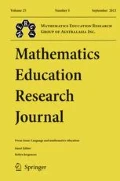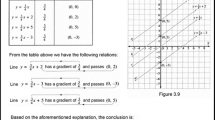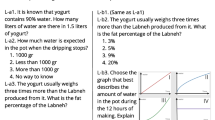Abstract
In this study, we investigated teachers’ teaching practices and their underlying beliefs regarding context-based tasks to find a possible explanation for students’ difficulties with these tasks. The research started by surveying 27 Junior High School teachers from seven schools in Indonesia through a written questionnaire. Then, to further examine teachers’ teaching practices related to context-based tasks, four teachers were observed and video recorded in two mathematics lessons in which they were asked to deal with context-based tasks. The questionnaire data revealed that the teachers had a tendency toward a view on teaching and learning mathematics which includes encouraging students to be actively involved in solving problems in various contexts. Although this finding suggests that the teachers may offer opportunities to learn context-based tasks to students, the questionnaire data also revealed that the teachers saw context-based tasks as plain word problems. Furthermore, the observations disclosed that their teaching was mainly teacher-centered and directive, which is not considered to be supportive for learning to solve context-based tasks. Combining the findings of this study with the results from our earlier study on Indonesian students’ errors when solving context-based tasks, we found a relationship between how Indonesian teachers teach context-based tasks and the errors Indonesian students make in solving these tasks. These findings support the conclusion that insufficient opportunity-to-learn to solve context-based tasks offered by teachers is a possible explanation for students’ difficulties in solving these tasks.







Similar content being viewed by others
Notes
The total number is more than 27 because some teachers taught in two grades.
Although Grade 9 students (the 15-year-olds) are the target group of the PISA studies, we did the observations in Grade 8 because that is where the basis for the performance in Grade 9 is laid. Moreover, the schools did not give permission to do observations in Grade 9 classes due to their preparations for the National Exam.
In total, 233 ninth-graders were involved in this previous study that was carried out in school year 2011–2012. The students came from the same schools as the teachers in the present study which took place in the school year 2012–2013 and involved teachers from Grade 7 to Grade 9. The test that was administered contained 34 questions distributed over four different booklets. Every student made 13 tasks. The analyzed data consisted of 3027 responses (students × tasks). Of these responses, 1,855 were correct, 346 were missing and 826 were incorrect which included 934 errors (because of the multiple coding, the number of errors is larger than the number of incorrect responses).
References
Adamson, S., Burtch, M., Cox, T., Banks, D., Judson, E., & Lawson, T. (2002). Nature of mathematics survey. Paper presented at the 28th AMATYC Annual Conference, Phoenix, Arizona, USA,November 14–17, 2002.
Antonius, S., Haines, C., Jensen, T. H., Niss, M., & Burkhardt, H. (2007). Classroom activities and the teacher. In W. Blum, P. L. Galbraith, H.-W. Henn, & M. Niss (Eds.), Modelling and applications in mathematics education (pp. 295–308). New York: Springer.
Barnes, M. (2000). ‘Magical’ moments in mathematics: insights into the process of coming to know. For the Learning of Mathematics, 20(1), 33–43.
Bell, C. V., & Pape, S. J. (2012). Scaffolding students’ opportunities to learn mathematics through social interactions. Mathematics Education Research Journal, 24(4), 423–445.
Beswick, K. (2005). The beliefs/practice connection in broadly defined contexts. Mathematics Education Research Journal, 17(2), 39–68.
Blum, W. (2011). Can modelling be taught and learnt? Some answers from empirical research. In G. Kaiser, W. Blum, R. B. Ferri, & G. Stillman (Eds.), Trends in teaching and learning of mathematical modelling (pp. 15–30). New York: Springer.
Blum, W., & Ferri, R. B. (2009). Mathematical modelling: can it be taught and learnt? Journal of Mathematical Modelling and Application, 1(1), 45–58.
Blum, W., & Leiss, D. (2007). How do students and teachers deal with mathematical modelling problems? The example “Sugarloaf”. In C. Haines, P. Galbraith, W. Blum, & S. Khan (Eds.), Mathematical modelling (ICTMA 12): education, engineering and economics (pp. 222–231). Chichester: Horwood Publishing.
Brewer, D. J., & Stasz, C. (1996). Enhancing opportunity to learn measures in NCES data. In G. Hoachlander, J. E. Griffith, & J. H. Ralph (Eds.), From data to information: new directions for the National Center for Education Statistics (pp. 3.1–3.28). Washington: U.S. Department of Education.
Chapman, O. (2009). Teachers’ conceptions and use of mathematical contextual problems in Canada. In L. Verschaffel, B. Greer, W. Van Dooren, & S. Mukhopadhyay (Eds.), Words and worlds. Modelling verbal descriptions of situations (pp. 227–244). Rotterdam: Sense Publishers.
Clements, M. A. (1980). Analyzing children’s errors on written mathematical task. Educational Studies in Mathematics, 11(1), 1–21.
Cooper, B., & Dunne, M. (2000). Assessing children’s mathematical knowledge: social class, sex and problem-solving. Buckingham: Open University Press.
Council, N. R. (2001). Adding it up: helping children learn mathematics. Washington: National Academy Press.
Erickson, F. (2006). Definition and analysis of data from videotape: some research procedures and their rationales. In J. L. Green, G. Camili, & P. B. Ellmore (Eds.), Handbook of complementary methods in education research (pp. 177–192). Mahwah: Lawrence Erlbaum.
Ernest, P. (1989). The impacts of beliefs on the teaching of mathematics. In P. Ernest (Ed.), Mathematics Teaching: the state of the art (pp. 249–253). New York: Falmer.
Eurydice. (2011). Mathematics education in Europe: common challenges and national policies. Brussels: Education, Audiovisual and Culture Executive Agency.
Forman, S. L., & Steen, L. A. (2001). Why math? Applications in science, engineering, and technological programs. Research Brief, American Association of Community Colleges.
Galbraith, P., & Stillman, G. (2006). A framework for identifying student blockages during transitions in the modelling process. ZDM The International Journal on Mathematics Education, 38(2), 143–162.
Gellert, U., & Jablonka, E. (2009). “I am not talking about reality”: word problems and the intricacies of producing legitimate text. In L. Verschaffel, B. Greer, W. Van Dooren, & S. Mukhopadhyay (Eds.), Words and worlds. Modelling verbal descriptions of situations (pp. 39–53). Rotterdam: Sense Publishers.
Graumann, G. (2011). Mathematics for problem in the everyday world. In J. Maasz & J. O’Donoghue (Eds.), Real-world problems for secondary school mathematics students: case studies (pp. 113–122). Rotterdam: Sense Publishers.
Grouws, D. A., & Cebulla, K. J. (2000). Improving student achievement in mathematics. Brussels: International Academy of Education.
Hagaman, J. L., Casey, K. J., & Reid, R. (2012). The effects of the paraphrasing strategy on the reading comprehension of young students. Remedial and Special Education, 33(2), 110–123.
Hiebert, J., & Grouws, D. A. (2007). The effects of classroom mathematics teaching on students’ learning. In F. Lester (Ed.), Second handbook of research on mathematics teaching and learning (pp. 371–404). Charlotte: Information Age Publishing.
Human Development Department East Asia and Pacific Region. (2010). Inside Indonesia’s mathematics classrooms: a TIMSS Video Study of teaching and practices and student achievement. Jakarta: The World Bank.
Husén, T. (Ed.). (1967). International study of achievement in mathematics: a comparison of twelve countries (Vol. II). New York: Wiley.
Karbalei, A., & Amoli, F. A. (2011). The effect of paraphrasing strategy training on the reading comprehension of college students at the undergraduate level. Asian EFL Journal, 13(3), 229–344.
Kletzien, S. B. (2009). Paraphrasing: an effective comprehension strategy. The Reading Teacher, 63(1), 73–77.
Kramarski, B., Mevarech, Z. R., & Arami, M. (2002). The effects of metacognitive instruction on solving mathematical authentic tasks. Educational Studies in Mathematics, 49(2), 225–250.
Landis, J. R., & Koch, G. G. (1977). The measurement of observer agreement for categorical data. Biometrics, 33(1), 159–174.
Lingefjärd, T., & Meier, S. (2010). Teachers as managers of the modelling process. Mathematics Education Research Journal, 22(2), 92–107.
Maass, K. (2010). Classification scheme for modelling tasks. Journal für Mathematik-Didaktik, 31(2), 285–311.
Maulana, R., Opdenakker, M.-C., Den Brok, P., & Bosker. (2012). Teacher-student interpersonal behavior in secondary mathematics classes in Indonesia. International Journal of Science and Mathematics Education, 10(1), 21–47.
Mortimore, P. (2009). Alternative models for analysing and representing countries' performance in PISA. A paper commisioned by Education International Research Institute. http://eiie.org/docs/webdepot/alternativemodelsinpisa.pdf. Retrieved in June 1, 2013
NCTM. (2000). Principles and Standard for School Mathematics. Reston: the NCTM.
Newman, M. A. (1977). An analysis of sixth-grade pupils’ errors on written mathematical tasks. Victorian Institute for Educational Research Bulletin, 39, 31–43.
OECD. (2003). The PISA 2003 Assessment Framework – Mathematics, Reading, Science, and Problem Solving Knowledge and Skills. Paris: OECD.
OECD. (2010). PISA 2009 results: What students know and can do. Student performance in reading, mathematics, and science (Vo. I). Paris: OECD.
OECD. (2013). PISA 2012 results: What students know and can do. Student performance in mathematics, reading and science (Vol. I). Paris: OECD.
Prakitipong, N., & Nakamura, S. (2006). Analysis of mathematics performance of grade five students in Thailand using Newman procedure. Journal of International Cooperation in Education, 9(1), 111–122.
Pusat Kurikulum. (2003). Kurikulum 2004. Standar kompetensi mata pelajaran matematika Sekolah Menengah Pertama dan Madrasah Tsanawiyah [The Curriculum 2004. The standard competences for Junior High School mathematics]. Jakarta: Departemen Pendidikan Nasional.
Sam, L. C., Lourdusamy, A., & Ghazali, M. (2001). Factors affecting students’ abilities to solve operational and word problems in mathematics. Journal of Science and Mathematics Education in Southeast Asia, 24(1), 84–95.
Sepeng, P. (2013). Use of unrealistic contexts and meaning in word problem solving: a case of second language learners in Township schools. International Journal of Research in Mathematics, 1(1), 8–14.
Stipek, D. J., Givvin, K. B., Salmon, J. M., & MacGyvers, V. L. (2001). Teachers’ beliefs and practices related to mathematics instruction. Teaching and Teacher Education, 17(2), 213–226.
Tornroos, J. (2005). Mathematics textbooks, opportunity to learn and student achievement. Studies in Educational Evaluation, 31(4), 315–327.
Treffers, A. (1987). Three Dimensions. A model of goal and theory description in mathematics instruction – The Wiskobas Project. Dordrecht: Reidel Publishing Company.
Valverde, G. A., Bianchi, L. J., Wolfe, R. G., Schmidt, W. H., & Houang, R. T. (2002). According to the book: using TIMSS to investigate the translation of policy into practice through the world of textbooks. Dordrecht: Kluwer Academic Publishers.
Van den Heuvel-Panhuizen, M. (2010). Reform under attack—forty years of working on better mathematics education thrown on the scrapheap? No Way! In L. Sparrow, B. Kissane, & C. Hurst (Eds.), Shaping the future of mathematics education: proceedings of the 33rd annual conference of the Mathematics Education Research Group of Australasia. MERGA: Fremantle.
Van den Heuvel-Panhuizen, M., & Drijvers, P. (2014). Realistic Mathematics Education. In S. Lerman (Ed.), Encyclopedia of Mathematics Education (pp. 521–525). Dordrecht: Springer.
Verschaffel, L., Greer, B., & De Corte, E. (2000). Making Sense of Word Problems. Lisse: Swets & Zeitlinger.
Verschaffel, L., Van Dooren, W., Greer, B., & Mukhopadhyay, S. (2010). Reconceptualising word problem as exercises in mathematical modelling. Journal für Mathematik-Didaktik, 31(1), 9–29.
Wijaya, A., Van den Heuvel-Panhuizen, M., Doorman, M., & Robitzsch, A. (2014). Difficulties in solving context-based PISA mathematics tasks: an analysis of students’ errors. The Mathematics Enthusiast, 11(3), 541–554.
Wijaya, A., Van den Heuvel-Panhuizen, M., & Doorman, M. (2015). Opportunity-to-learn context-based tasks provided by mathematics textbooks. Educational Studies in Mathematics, 89(1), 41–65.
Wilkins, J. L. M. (2008). The relationship among elementary teachers’ content knowledge, attitudes, beliefs, and practices. Journal of Mathematics Teacher Education, 11(2), 139–164.
Xin, Z., Lin, C., Zhang, L., & Yan, R. (2007). The performance of Chinese primary school students on realistic arithmetic word problems. Educational Psychology in Practice, 23(2), 145–159.
Acknowledgments
This research was supported by the Indonesian Ministry of Education and Culture under the project of Better Education through Reformed Management and Universal Teacher Upgrading (BERMUTU) IDA CREDIT NO.4349-IND, LOAN NO.7476-IND.
Author information
Authors and Affiliations
Corresponding author
Appendix
Appendix
Rights and permissions
About this article
Cite this article
Wijaya, A., van den Heuvel-Panhuizen, M. & Doorman, M. Teachers’ teaching practices and beliefs regarding context-based tasks and their relation with students’ difficulties in solving these tasks. Math Ed Res J 27, 637–662 (2015). https://doi.org/10.1007/s13394-015-0157-8
Received:
Revised:
Accepted:
Published:
Issue Date:
DOI: https://doi.org/10.1007/s13394-015-0157-8




